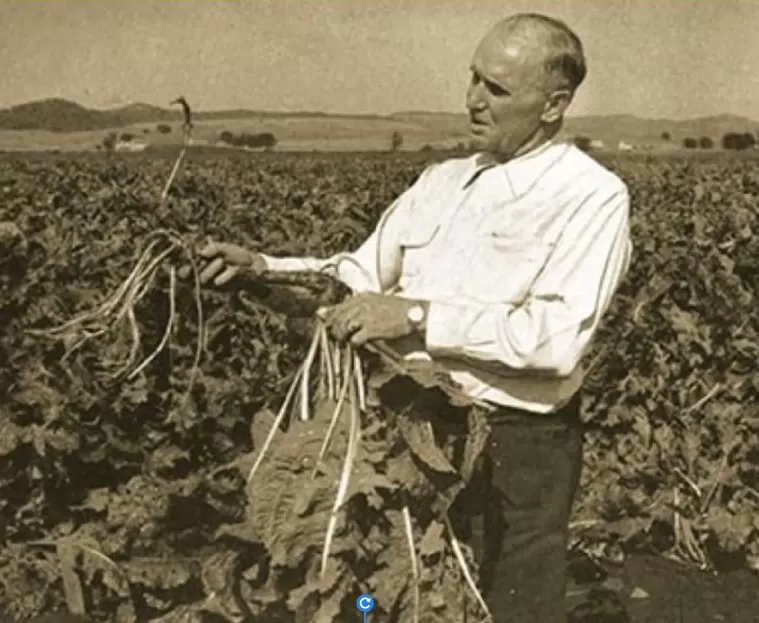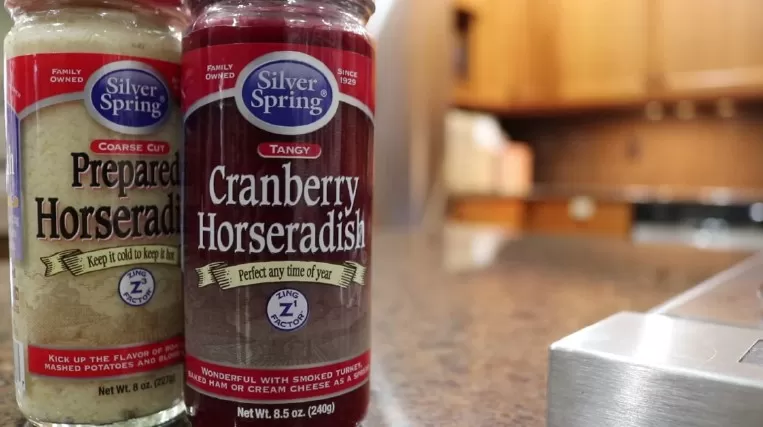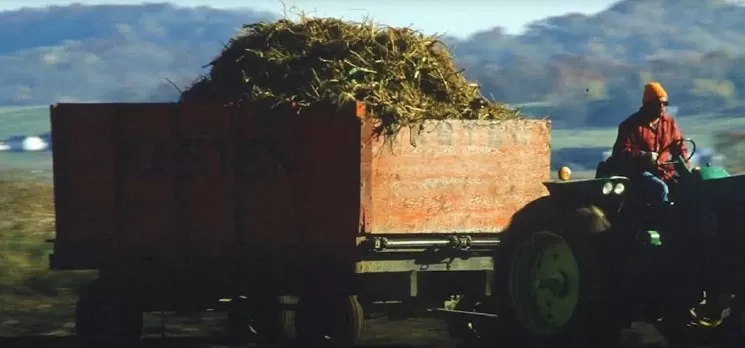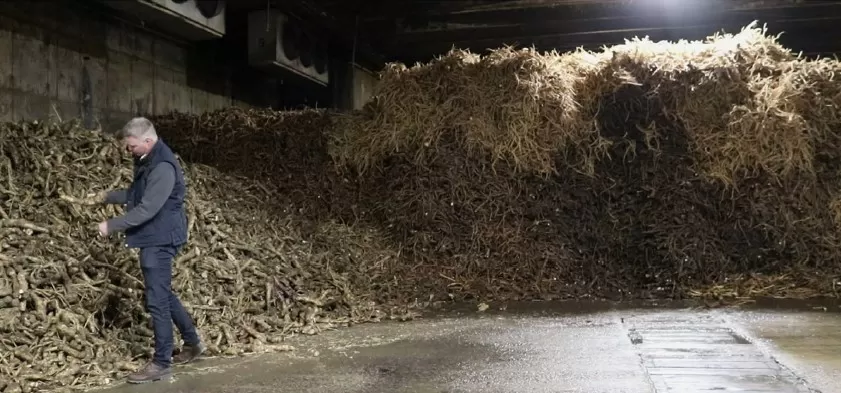The Horseradish Kings Bring the Zing with Silver Spring
Posted:
Photo above: Eric Rygg, president of Silver Spring Foods and Kyle Bechel, farm manager of Huntsinger Farms, stand in front of a custom-made horseradish harvester on Dec. 15, 2023 in Eau Claire, Wisconsin. Noah Fish/Agweek![]()
![]()
EAU CLAIRE, Wisc. - Eric Rygg pulled a pocket knife from his jacket and shaved off a white sliver from the dirt-crusted root of a horseradish.
"You want to try a little piece?" asked Rygg, president of Silver Spring Foods and Huntsinger Farms, while standing in the cold storage room of the operation which holds from 1 million to 2 million pounds of horseradish for months until it gets processed.
Silver Spring Foods and Huntsinger Farms was started in 1929 by Rygg's great-grandfather, Ellis Huntsinger.
History in Horseradish
"He was actually a door-to-door lightning rod salesman before that, and there's only so many repeat customers you can have for that," Rygg said. "He ended up falling back on on agriculture and farming, because that's what his parents did to help support his family."
Ellis Huntsinger, founder of Silver Spring Foods and Huntsinger Farms. Contributed/Silver Spring Foods
Huntsinger began the operation by growing fruits and vegetables, including horseradish, near a spring south of Eau Claire. He prepared and bottled horseradish by hand in a shed behind his house and sold it locally to help augment his income during Wisconsin's cold winter months.
"Horseradish likes to be kept cold," Rygg said. "We're right near the 45th Parallel, in this region, so the climate is really good for horseradish, and the soil is really good for horseradish, and so the product really flourished."
The company's products can now be found in just about every supermarket in the country and they are also distributed in Europe, Japan and Australia.
"We are the world's largest grower and processor of horseradish," Rygg said. "We are the No. 1 refrigerated brand of horseradish in the U.S."
In 1972, then-Silver Spring Foods president Edwin Bartusch and his wife, Betty, died in a plane crash. Barbara, the younger of their two daughters, and her husband, also died in the crash. Rygg's mother, Nancy Bartusch, was 22-years-old at the time and was enrolled in business school in California.
"My mom inherited the company at that point, at 22-years-old, so she's third generation, and I'm a fourth generation horseradish farmer," Rygg said. "Pretty rare to get to this point."
Rygg said the focus on quality and service are key to the company's success, 94 years later.
"I think if Ellis Huntsinger were around, he'd be thrilled about the growth of the company, and what we're doing, and how we're in so many different markets," Rygg said.
Production Scale
Today, Silver Spring Foods processes anywhere from 7 million to 9 million pounds of horseradish per year, Rygg said, but the company produces a lot more than just horseradish.
Silver Spring Foods products on Dec. 15, 2023, in Eau Claire, Wisconsin. Noah Fish/Agweek
"In the plants, as far as overall condiments, we're processing a little over 100 million pounds of product a year," he said. "Any kind of portable condiment, in a whole variety of different packages, retail sizes, some industrial sizes - we can do pails, we can do drums, and we can do a 2,200-pound tote, if you so prefer, and we can even do a tanker load of horseradish if you need that much horseradish."
Silver Spring Foods makes about 400 different items, all in the condiment space, and employs around 240 people.
"Our mission is to make your food taste better - not the same or worse," Rygg said. "We like to bring excitement and flavor to the food you eat. Give it zing with Silver Spring, for short."
Growing and Harvesting
Growing horseradish is a relatively simple process, Rygg said, but it's labor intensive.
"You could grow your own horseradish pretty easily, but the problem with growing your own horseradish is that it can kind of take over your garden," he said. "Harder to get rid of, maybe, then to grow it."
Huntsinger Farm workers plant horseradish using custom-built equipment, similar to potato planters, and harvest with modified potato-diggers which reach deep into the soil to remove as much of the root complex as possible.
"It's not like we can go to John Deere and buy a horseradish harvester, because there's not a very big market, and aren't very many of us who do horseradish farming or horseradish processing," Rygg said. "Certainly no one's doing both farming and processing at the scale that we're doing it. So we've modified a lot of our equipment over the years."
An archive photo of a horseradish harvest in Eau Claire, Wisconsin, at Huntsinger Farms. Contributed/Silver Spring Foods
Horseradish is grown at Huntsinger Farms in a five- to seven-year rotation with corn, soybeans and other forage crops on approximately 9,000 acres of farmland, and the horseradish roots are harvested in the spring and fall.
Kyle Bechel, farm manager of Huntsinger Farms, grew up on a dairy farm close to where the operation is headquartered today. He said that rotating horseradish with corn, soybeans and other crops is crucial to preparing the land for horseradish.
"It allows us to dictate what happens on that ground ahead of the horseradish, and to prepare it," Bechel said. "This land is very fertile, and it's been well-taken care of, through the history of the farm."
When horseradish is taken out of the ground, pieces of the root are cut off (which are called sets) and replanted to grow into the next year's crop.
"We leave it in the ground for about 12 months to 18 months, and so1netimes up to two years, before we're ready to harvest, and in the meantime it's developing a lot of flavor in bulk," Rygg. said. "We like to say the horseradish bulks up for the winter, so it does like this nice cold weather that we have here in Wisconsin."
Grinding, Processing, Mixing
Roots are then placed in cold storage until they are processed, which consists of grinding and mixing the horseradish with vinegar, salt and water. Rygg said that grinding horseradish is similar to chopping onions, and brings a tear to the eyes.
Eric Rygg, president of Silver Spring Foods, examines horseradish roots inside a cold storage room at Huntsinger Farms on Dec. 15, 2023, in Eau Claire, Wisconsin. Noah Fish/Agweek
"When you think about grinding horseradish, that's when we release all that heat," he said. "Vinegar actually helps stop the heat generating process, and then preserve that heat for a long period of time, so we can help consumers out by taking some of the tears out."
Horseradish is mixed by Silver Spring Foods into a variety of different condiments including mustards, salad dressings, barbecue sauces and more. A popular mix made by the company is with tomato or ketchup, to make a cocktail sauce.
Ellis Huntsinger discovered that adding sweet dairy cream to his prepared horseradish helped further enhance the falvor, heat and longevity of the product, which helped him expand sales to markets throughtout the country. The longevity part was the most important, Rygg said, because unlike wine, horseradish does not get better with age.
"It's the hottest the day that we grind," he said. "Every day after that, it loses a little bit of its heat."
Rygg said that his great-grandfather's discovery of adding sweet cream was actually made by mistake.
"They spilled some dairy cream in the prepared horseradish product, and didn't think much about it, and put it in the fridge like they would for the normal prodcut and forgot about it," Rygg said.
A couple months later, the horseradish with the sweet cream was pulled out from the fridge and tasted, and it was found to have preserved a lot of its heat and freshness.
"So with this new innovative cream style product that they ended up bringing to market, they had an extra month of shelf life compared to anything else," Rygg said. "It really gave them an advantage in bringing that product to market because that's a huge value to retail customers, when they buy it."
###
Send this blog post to someone:
SUBMIT